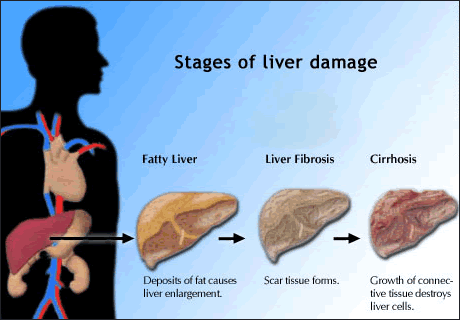By
Liz Highleyman
Injection drug users (IDUs) often contract blood-borne diseases
such as hepatitis C and HIV
by sharing syringes and other injection equipment. Over years
or decades, a proportion of people with chronic hepatitis C
will develop severe liver disease including advanced fibrosis,
cirrhosis (scarring),
and hepatocellular
carcinoma (a form of liver cancer).

Ava
John-Baptiste from the University of Toronto and colleagues
performed a literature review and meta-analysis to estimate
the rate of progression to liver cirrhosis among people infected
with HCV through injection drug use.
The investigators searched published literature for articles
assessing development of cirrhosis in IDU populations. They
collected data on cirrhosis prevalence, proportion of men in
the population, average patient age, mean duration of HCV infection,
mean alanine aminotransferase (ALT) level, proportion with HIV
coinfection, and proportion of heavy alcohol users.
Results
 |
A
total of 47 relevant published articles were identified,
out of which 44 studies representing a total of 6457 patients
were included in the final analysis. |
 |
The
estimated rate of progression to cirrhosis was 8.1 per 1000
person-years, after adjusting for confounding factors. |
 |
This
corresponds to a 20-year cirrhosis prevalence of 14.8%. |
 |
The
rate of liver disease progression was faster in populations
that included a higher percentage of men and/or heavy alcohol
users. |
 |
However,
a 5% increase in the proportion of HIV/HCV coinfected people
or an ALT increase of 5 IU/L were not associated with faster
progression. |
These
findings led the study authors concluded, "Analysis of
aggregate level data suggests that for patients who contracted
HCV through injection drug use, prognosis is poor in populations
with many male patients and high levels of alcohol consumption."
Investigator affiliations: Department of Health Policy, Management
& Evaluation, University of Toronto, Canada; Toronto Health
Economics and Technology Assessment Collaborative (THETA), University
of Toronto, Canada; University Health Network, Toronto, Canada;
Dalla Lana School of Public Health, University of Toronto, Canada;
Department of Medicine, University of Toronto, Toronto, Canada.
9/14/10
Reference
A John-Baptiste, M Krahn, J Heathcote, and others. The natural
history of hepatitis C infection acquired through injection
drug use: Meta-analysis and meta-regression. Journal of Hepatology
53(2): 245-51 (Abstract).
August 2010.
